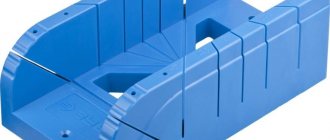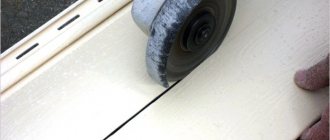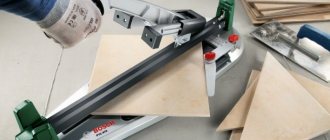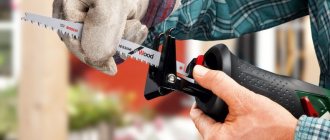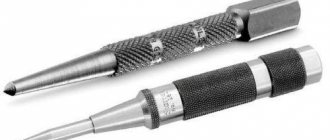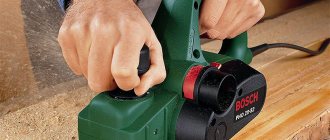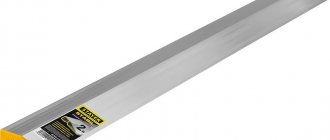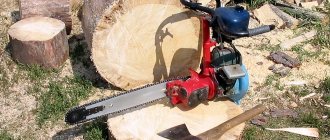Design and principle of operation of theodolite
The basis of the theodolite is a telescope that rotates in horizontal and vertical planes. The pipe is connected to a microscope, with the help of which you can obtain the values of the angles marked on the dial, and when using a special rangefinder rod, it is also possible to determine the distance between points as when → working with a level (how to work with a level is described in the link).
The principle of theodolite surveying is to obtain unknown values of the coordinates and heights of the required point, based on points with known values.
Before starting the survey, the theodolite must be brought into working position. The instrument is installed on a tripod above a point with known coordinates and is brought to a horizontal position with special screws located on the stand (1). Through the eyepiece (2) we see the center of the sighted point over which we install the instrument, and the levels (3) help us control the horizontal position of the instrument. By working with the clamping screws of the tripod and stand, we achieve a position where the instrument is installed horizontally above the starting point. For beginners, this procedure causes some difficulties, but experts center the theodolite in less than a minute. In high-precision instruments, the centering system is optical; in others, a plumb line on a thread is used.
Next, use the sight (8) to roughly aim at the target, and with the screws (4,7) we smoothly move the reticle to the center of the object being photographed, controlling the process with the help of a telescope (9). Since the instrument is optical, it is impossible to take a reading in the dark. To work, we will need to adjust the mirror (10) so that as much light as possible enters the system. After sighting the target, we take a reading using the microscope eyepiece (11).
The main difference between a theodolite and a total station
A tacheometer and a theodolite have differences, despite the apparent similarity of these instruments at first glance.
For example, using a total station you can photograph objects located at a much greater distance than using a theodolite.
Tacheometers have much more capabilities, but such a device will cost more.
This device is more advanced, but not everyone can afford it. As a rule, tacheometers are mainly at the disposal of large companies and enterprises.
Theodolite is cheaper and is present among the set of measuring devices almost everywhere where it is needed.
Taking readings with a theodolite
A countdown is a number consisting of degrees, minutes and seconds (not always seconds). Looking through the microscope, we will see the upper and lower scales, marked, respectively, for taking readings along a vertical and horizontal circle.
There is a scale microscope and an evaluator microscope (line microscope). The evaluator microscope immediately shows the required angle along the horizontal and vertical axes in degrees and minutes, although the accuracy is slightly lower than that of a scale microscope, since the minimum division is 10 minutes, and with an accuracy of up to a minute you have to determine it by eye.
Evaluating microscope (left) and theodolite scale microscope
There are 2 scales that change their position in relation to each other - the limb scale and the alidade scale. In a scale microscope, the alidade scale is marked with numbers from 1 to 6 and 60 divisions, corresponding to 60 minutes. The alidade scale is movable.
In a scale microscope, the value of degrees will be the number that falls on the alidade scale for a horizontal angle or, accordingly, a vertical one. The value in minutes will be the number indicated by the degrees of the dial on the alidade scale. For example, in the picture below we will see the values of the horizontal and vertical angles, respectively, 181 degrees 43 minutes and 121 degrees 2 minutes
Comparison of measuring devices
Both a level, a theodolite, and a tacheometer allow you to place points on a piece of terrain, determining the required coordinates. To see how they differ, it is worth comparing them with each other.
Most often, a level is used in this category, but its main capabilities are limited only to determining vertical angles.
In this regard, the theodolite has more capabilities, since it is equipped with two axes for measurements. In addition to determining vertical angles, it also allows you to calculate horizontal angles.
A tacheometer is an even more advanced device with a wide range of functions. It can perform the tasks of a level and theodolite, and, in addition, also calculate the distance to given points and objects. The built-in rangefinder, using a laser beam, successfully determines linear values. This type of shooting, in turn, greatly simplifies the calculations. Many tacheometer models are capable of automatically performing complex calculations on their own. All information and data obtained during operation are recorded in the device’s memory and used when necessary.
Some tacheometers require modular assembly. In this case, you can assemble the device for specific actions and tasks, while eliminating unnecessary functions that are unnecessary for this work.
Accuracy of readings
Over time, the bearings in the device can wear out, which negatively affects the obtained values. To do this, the reading is taken several times, at different values of the circle (limbe) of the microscope.
To eliminate collimation errors, the telescope is moved through the zenith, the theodolite is rotated 180 degrees and readings are taken again. From several values, an arithmetic mean is obtained, which will be the correct value of the measured angle. If the readings differ significantly (more than a minute), the procedure should be repeated.
In addition to the method of translation through the zenith, there is a method of half-steps, when the dial is shifted by an integer value of the angle of degrees and the count is taken a second time. To rearrange the dial, there are screws (5, 6). For example, the horizontal angle value is 358 degrees 45 minutes. After taking the reading, use screw (6) to shift the starting point of the dial by an integer value of degrees of angle (for convenience), securing it with screw (5). For example, by moving the dial by 90°, we should get an angle value in a horizontal circle of 358°45′ + 90° = 88°45′.
Carrying out surveys using a theodolite and level
Basics of working with geodetic instruments
Surveying with a theodolite
Installation of the device
Before starting theodolite survey, the device must be installed strictly above the vertex of the angle being measured, above the reference point from which measurements are taken. During underground surveying, a theodolite is sometimes installed under the reference point. The height of the optical tube of the device should be at eye level. The device is installed along an optical or thread plumb line, first moving the tripod roughly, “by eye,” then, by moving along a horizontal platform, the position above the apex of the corner (reference point) is specified. The vertical position of the theodolite rotation axis is performed using a cylindrical level.
After fixing the device, check the correct installation by rotating the theodolite in a horizontal plane and observing the position of the cylindrical level bubble. The deviation should not exceed one scale division. The installation of the optical tube should allow you to clearly see the reticle scale and the observed object. The dial strokes and the reading microscope scale should also be clearly visible.
Angle measurement
Release the alidade and move it to the left 30-40 degrees, then reverse rotation and point it at the sighting point of the first direction so that it is to the right of the bisector (in the field of view of the optical tube). The alidade is secured. By screwing in the alidade aiming screw, the bisector is aimed at the sighting point and a reading is taken from the optical micrometer.
Loosen the alidade mounting screw and aim at the second sighting point, then take a reading, following the same steps as when aiming at the first point.
Next, the second stage of surveying is carried out, which reduces the errors that appear as a result of inaccurate installation of the theodolite. The optical tube is moved through the zenith in the opposite direction and turned clockwise to the second point of the measured angle, having previously moved the alidade by 30-40 degrees. to the left. Using a guiding screw, the bisector is aimed at the sighting point and the readings of the optical micrometer are taken. The alidade is pointed clockwise at the first sighting point and the micrometer readings are taken again.
If the theodolite is equipped with an ocular micrometer instead of an optical one, the measurement results are repeated three times.
At this point, the practical part of the angle survey is completed; we begin to calculate the average measurement result of the first and second stages, which allows us to reduce survey errors. The discrepancy in angle measurements obtained in duplicate surveys should not exceed double the accuracy of the reading device (for the T30 theodolite this error is 1′).
To measure vertical angles, use a vertical theodolite circle.
Measuring magnetic azimuths
The theodolite is brought into working condition, and a compass is attached to the end of the alidade.
By rotating the alidade on a horizontal circle, the zero value is set. After this, the alidade fixing screw is tightened, and the dial screw is loosened, and by rotating the alidade, the brussoli arrow is brought into balance with the index strokes, while the tube lens and the northern brussoli arrow should coincide in direction. The dial screw is secured. After performing these operations, the horizontal circle is oriented along the Earth's magnetic meridian. Then, by rotating the alidade, the telescope is aimed at the sighting point and a reading is taken along a horizontal circle. The reading obtained in this way is the magnetic azimuth of the sighting point.
Determining the height of a building with a theodolite (+ video)
For example, consider the formula for determining the height of a building, structure, pole, etc. We take the readings of the values indicated in the figure below with a theodolite and a measuring tape and write them down in a table (notebook).
The theodolite is placed at a distance no less than the height of the building; if this is not possible, then as far as possible from the object. Next, according to the formula h = h1 + h2 = d(tgv1 + tgv2)
calculate the height of the building.
If line AB has a slope on the ground, it is necessary to calculate the horizontal location of this line, its projection onto the horizontal plane using the formula d = Scosν
taking readings as shown in the figure below.
Horizontal line layout
This video will tell you how to determine the height of a structure, with calculations and formulas.
Application of geodetic theodolite
A theodolite is a device that allows you to measure angles in both horizontal and vertical directions.
It will allow you to find out the angle between different points with the highest accuracy.
The need to tie a building to a certain point is explained by the importance of determining the angle between them. Obtaining accurate results allows you to calculate the profile of the road, the contour of the structure, etc.
Optical systems of theodolites, depending on the accuracy of the results, are divided into 3 groups:
- Technical. The error in the result can be up to 1 minute.
- Precision. The error is up to 1 minute. They allow you to monitor the deformation of structures that inevitably occurs during operation due to the influence of the external environment and the weight of the object itself.
- Precision theodolites are most widely used in construction work. They provide an error of 2-3 seconds.
In addition to determining angles, theodolite is also used in other areas: for example, in metrology, as well as for calculating the trajectory of a rocket.
Theodolites are used not only in construction work, but also in forestry or land reclamation, in all those areas where it is necessary to carry out high-precision measurements.
Measuring a horizontal angle with a theodolite (+ video)
To measure a horizontal angle with a theodolite, you need to install the theodolite in one of the corners of the triangle. Determine right and left direction. Where the zero will be located on the scale is not important, we can get the angle value as the difference in the readings of two points. Aim at the first point and take a reading. Using one of the methods above to check the value, take the reading a second time and calculate the average value; if the discrepancy is no more than 1 minute, then the measurements were made correctly. We record in a journal (notebook). Next, we aim at the second point, and also take a reference. If the value of the right angle is less than the left, you need to add 360 degrees to it. The difference in readings will be our angle.
Use of tools in the construction industry
This is one of the reasons for its popularity in various industries. Depending on the need, you can use an electronic or mechanical tool. If it is very important to have the most accurate readings, then it is best to use those devices that use a laser.
Why is theodolite used in construction? Because this device helps to control the vertical and horizontal angles, which is important in the construction of buildings, especially with regard to multi-story buildings. There is no foundation yet, but the theodolite should already be in the hands of the builder. Using such a tool, it is possible to calculate the angle of inclination of the terrain. If you don’t think about this point, then the likelihood of the building being skewed is very high.
Then the theodolite is used to build subsequent floors. This will prevent the construction of the “Leaning Tower of Pisa”. Moreover, such a device helps to significantly save time on manual calculations and measurements. To navigate the results obtained, it would not hurt the master to know the basics of geometry.
If you can somehow manage without such a device in private construction (although this is not recommended), then for developers of multi-story buildings it is simply irreplaceable. After all, not only will the reliability and quality of the structure depend on this, but the theodolite also helps to create a more accurate estimate. Therefore, if a team of builders is hired, then it would be useful to familiarize yourself with their tools, which can tell you a lot.
Qualified specialists always take their work seriously, which cannot be done without the appropriate tools and materials.
Polar method of surveying with theodolite
In construction, two surveying methods are mainly used - polar (Fig. 1) and the method of alignments and perpendiculars (Fig. 2). Other methods of surveying with a theodolite: the method of corner intersections, linear intersections, the method of auxiliary alignments and the bypass method.
With the polar method
we start from two points with known values. These points can be taken from an existing project, plan, state geodetic network (if there is an SRO), or when independently developing a plan, you can set these points yourself, starting from a self-defined zero along x;y;z coordinates. The polar method can be closed or open.
Let's first consider the open-loop method, which we will then lead to the closed one. The tool is set to origin point 2, the initial reference is taken to origin point 1, or vice versa. The distance is measured with a tape measure, measuring tape or rangefinder to theodolite traverse point 1, and a mark is installed (a peg flush with the ground, or a vertical rod). The left-hand angle to theodolite traverse point 1 is measured. Having reached survey point 2, we sequentially calculate the values of the horizontal angles to each of the contour points (Fig. 1). In this way, you can also measure the distances to the points of the object being photographed and vertical angles from any point of the theodolite traverse you need. Next, using formulas to calculate the required values and distances, many calculations are given in several videos on this page.
The last stage is “linking” the theodolite traverse to known points and creating → a terrain plan on paper (the link tells how to make a plan or diagram of the terrain). Since the control points are in the same coordinate system, this polygon can be made closed by moving from control point 2 to the starting point 1. Next, you need to calculate the error of a closed theodolite traverse, which is calculated more easily than for an open one.
Procedure for working with a theodolite
There are two ways to work with a theodolite:
- Polar. The measurements are based on two points with known values. Calculations are made from the second point to the first. Next, measure the distance between them. The final stage is linking the theodolite traverse to each of the marks.
- Using alignments with perpendiculars. This method is used in the production of marking works. It consists of laying right angles on the ground as the device passes each mark step by step.
The instructions for the theodolite clearly state that before you start working with the device, you need to configure it. The preparatory stage includes:
- Centering.
- Leveling.
- Focus.
Error of closed theodolite traverse, discrepancy
As a result of simple calculations, we obtain a discrepancy, which we compare with the acceptable one. If the value is within tolerance, the error spreads proportionally to the sides of the polygon.
For a closed theodolite traverse, the error is determined by the formula:
Where is the actual (measured) sum of angles, and is the theoretical sum of angles, that is, which should be according to the laws of geometry.
The theoretical sum of angles is calculated using the formula:
Where n is the number of measured angles.
The permissible error of the sum of the angles of a closed theodolite traverse is determined by the formula:
If the actual error is greater than the permissible one, we check the records again; if this is not the problem, we take the readings again. If the error is less than or equal to the permissible one, we calculate the correction using the formula:
The value is spread across all angles. If the number is not an integer, we introduce corrections to some angles more than to others.
Features of the device design
Older types of devices consisted of a ruler on the long end of a needle placed in the center of a circle. The movement was like moving the needle of a compass.
Cutouts were made on the ruler, a thread was pulled through them, and a reporting index was obtained. After this, one side was aligned with the ruler. It was turned, report 1 was obtained. The second side was combined with the ruler, report 2 was obtained. Then the difference between the indicators was found. The resulting indicator was taken as the angular value.
In this design, the ruler was called an alidade, and the circle for obtaining the angular value was called a limb.
In modern instruments, the principle of operation remains the same, the names have not changed either. The alidade is connected to the sides of the corner using a special telescope that can move in both azimuth and height.
A special device on the dial scale allows you to count. A system of axes is used to set the elements in motion. A hard metal casing is used to protect the theodolite elements.
The movements of the elements - alidade and limb - are adjusted using screws. To carry out marking, the theodolite is installed on a flat surface using a tripod. The center of the dial is aimed at a plumb line. For this, a separate element is used - a plummet, which is also called thread oats. During the measurement, the sides of the angle are projected onto the plane of the circle using a collimation plane. They are formed when the sighting axis of the pipe moves. Sighting is carried out using two threads (vertical and horizontal) located along the diameter. If such threads are at the same distance from the horizontal thread of a simple cross, then they are called rangefinder.
Determining distance with a theodolite using a rangefinder rod
Using a theodolite, you can determine the distance to the point of taking readings, with an error of approximately 10 cm. We install the rangefinder rod at the point to which we want to measure the distance. The theodolite's reticle has 2 rangefinder lines located at the top and bottom. Measuring distance is simple. We count the number of centimeters from one horizontal rangefinder line to another and multiply the resulting value by the rangefinder coefficient of the pipe, which is usually equal to 100.
Determining distance with a theodolite using a rangefinder rod along rangefinder threads
In the example given, the distance to the batten will be approximately 19.4 meters.
Comparison
First of all, we should take a closer look at the functionality of the two measuring devices. The difference between a theodolite and a level is that the first of these devices is more universal. Using a theodolite, you can make linear and angular measurements, in both planes: horizontal and vertical.
For example, a theodolite will be indispensable when it is necessary to determine how much the wall of a building has deviated from the vertical. The level's specialization is narrower. Using this device, you can calculate the difference in levels or build guides that help obtain perfectly flat surfaces. The level will be useful, say, when laying bricks or pouring a foundation.
The capabilities of the instruments are determined by the features of their design. All details of the equipment depend on the specific model of theodolite or level, as well as on what type of device it is: optical, laser or digital. But in general, the theodolite is more complex. It has an additional measurement axis, which the level does not have.
To measure values, the theodolite has two circles with markings (limbs): the horizontal one determines the direction angle, and the vertical one determines the inclination angle. To point at the objects under study, both devices use an optical tube. When working with a level, a separate staff with divisions is also used.
A few words should be added about the difference between a theodolite and a level regarding the scope of their use. Since the theodolite has richer functionality, the range of areas where it is needed is wider. This is not only construction, but also land reclamation, astronomy, as well as other areas of activity in which accurate calculations are important. The level, accordingly, has a limited scope of application.
Construction work currently does not take place without the use of special geodetic instruments. These instruments are called theodolite and level: the difference between them is great, although there are quite a lot of similarities. Therefore, questions often arise about how these two devices differ, what are the features of using each of them.
Using a level, you can establish the exact location of an object in space, and using a theodolite, measure horizontal and vertical angles.
What is a theodolite?
Theodolite is a device designed to measure vertical and horizontal angles. Also applicable for determining distances using a filament rangefinder and magnetic azimuths using a compass. Used for geodetic work, construction, topographic surveys, etc.
There are two types of theodolites: optical and electronic. More modern electronic models are able to accurately determine angles, the height of a building, break a rectangle, or check the alignment of a building’s axes. The theodolite is easy to operate, lightweight and affordable. In this article we will tell you how to work with a theodolite to obtain the most accurate result.
Advantages of theodolite
A goniometric apparatus such as a theodolite has a number of advantages:
- High accuracy of measurements.
- Ability to take measurements in different climatic conditions.
- The device can be used in areas with any terrain.
- Compact and mobile.
- Relative ease of calibration and adjustment.
Theodolite device
The main elements that make up a theodolite:
- Dials with degree and minute divisions (horizontal and vertical).
- Alidade is a movable part of the theodolite, to which the dial and sighting system is attached.
- Telescope (sighting device) with fixing and aiming screws.
- Plumb to center over a point. It can be both optical and laser.
- A tribrach (stand) with lifting screws and a round level for leveling the theodolite.
- Microscope for taking readings.
The complete set of theodolite depends on the area in which it will be used. It can be supplemented with a compass guide, rangefinder attachments, sighting markers, etc. In some works, highly specialized theodolites are used: surveying, astronomical, gyroscopic.
Basics of Field Use
A theodolite is not a calculator that you can turn on and intuitively understand its buttons. But working with a theodolite is not difficult if you follow some basic recommendations. The basic sequence of operations consists of the following steps:
- Before starting work, you should read the instructions for your specific device model . Many, even professional craftsmen, for some personal reasons, miss this important step, but it is the operating instructions and other technical documentation of the manufacturer that will allow you to understand the purpose of screws, buttons and keys and find out how to work with a theodolite faster and more clearly attempts at self-study.
In addition to a general description of the device, the instructions for use usually contain a sequence of actions for topographic and geodetic surveys with visual illustrations of measurements. Safety rules and proper storage of the tool will also be useful, allowing you to seriously increase its service life.
- Before starting the actual measurement work, the theodolite is installed in the working position , which consists of sequentially performing the following actions:
- reliable fixation, without any wobble, of the tripod legs on the ground or any hard surface directly affects the accuracy of the resulting readings;
- centering the device over the apex of the angle is achieved by aligning the vertical axis of rotation of the telescope with the apex of the measured angle;
- setting the instrument horizon - the vertical axis of rotation of the theodolite must be brought to a strictly vertical plumb position;
- correct positioning of the telescope comes down to clearly focusing the image of the grid of threads by rotating the ocular knee to the vision of a particular person;
- The installation of a reference system for optical instruments is the precise focusing of images of scales or bar coding of horizontal and vertical circles by rotating the knee of the microscope eyepiece.
Centering of the device and its leveling is carried out by the method of successive approximations.
- Two reference points of the terrain are selected as measurement objects, taking into account the characteristics of the site, or control points of the building structure - A and B. The distance between the selected points should fall in the range of 100 - 400 meters , the specific value of this indicator depends on the scale of the theodolite survey being carried out and the required accuracy of angular measurements.
Precise aiming of the telescope to points A and B is performed by the focusing ring of the telescope and the diopter ring of the optical plummet.
- The sighting tube is pointed at point A until it is located on the vertical axis of the reticle and readings are taken along the horizontal dial, the measurement results are recorded in a field journal (for optical theodolites) or displayed on a liquid crystal display and stored in the internal memory of the device (for electronic instruments).
Step-by-step instructions on how to use a theodolite
- 1 step. When working with geodetic equipment, it is worth considering that in order to obtain accurate measurement results, it is necessary to carry out regular checks and adjustments of the theodolite. In addition, it is necessary to periodically monitor the geometric parameters, since the results of the work of a surveyor or builder sometimes do not tolerate errors even of a few arc seconds.
- Step 2. Once the equipment has been checked, you can begin working with the theodolite. First, you need to fix the device above a point with known coordinates, using a tripod and a plumb line or a plumb line. Taking it as a reference point, use levels and guide screws to center the device. The result should be an absolutely horizontal position of the device, as well as the location of the theodolite strictly above the point.
- Step 3. Using the sighting device, you must first aim at the target, and use the screws to align the reticle with the target as accurately as possible. This way the center of the measured object is determined. These actions are performed using a spotting scope, but if there is insufficient light, you can additionally use a special backlit mirror. After completing this procedure, measurements of the vertical and horizontal angles are taken using a theodolite microscope.
- Step 4 To obtain high reliability of measurement results, it is recommended to repeat measurements with a theodolite several times (techniques). Based on the results of repeated measurements, the average values of vertical and horizontal angles are determined.
Sequence of measurement work
Installation of the device
It is necessary to find an area with flat terrain. It will serve as a reference point by which you will need to center the device.
Centering is carried out using a level and using clamping screws. Its goal is to obtain a strictly horizontal position of the device in space.
Catching an object
Using a viewfinder, you need to find a point whose coordinates should be calculated and point the measuring grid at it. For a more accurate result, you need to use screws. After the center is set, it is necessary to fix its value.
Processing the results
Since the accuracy of calculations is everything to us, it is advisable to carry out not one, but a series of measurements, each time taking a new starting point. If the new values differ from the old ones exactly by the angle between the old and new reference points, then the result is considered true. Otherwise, you need to take a couple more measurements and calculate the average value.
Features of the level device
A level is a device necessary for leveling, that is, determining the excess of the horizontal height at several points.
This tool is used in construction, for example, for laying floors, pouring foundations, laying tiles and even wallpapering. Using a level, you can obtain smooth surfaces by constructing horizontal and vertical guides. The most simple in design - an optical device - includes several structural elements that allow you to make the necessary measurements using this device.
The level consists of a telescope with an eyepiece. The pipe is fixed to the stand with a whole system of screws, with the help of which the tool is also rotated horizontally. A mirror is fixed inside the pipe with damping parts.
The working position of the level is given using a screw. If you need to take a reference point, the horizontal movement of the device is carried out by an elevation screw.
The horizontal sighting axis is held by a compensator that operates automatically. It allows you to increase the accuracy of measurements.
Using a level allows you to obtain the most accurate measurement results. The software allows you to quickly process the received data, and the storage device allows you to record measurements.
At the moment, there are 3 main types of levels used for different types of work:
- laser;
- electronic (digital);
- optical.
Each type of this device has its own design features that affect the popularity of the devices.
Laser level device
Nowadays, laser levels are common in construction, since these tools are the easiest to use. A design feature of such a device is the presence of a laser emitter. With its help, a laser beam is sent into space through an optical prism.
Laser beams form 2 intersecting perpendicular planes in space. By focusing on them, you can easily level the surface.
Laser devices can be rotary. Their difference is that such a device has an electric motor, which allows it to work faster and rotate the emitter 360º.
In laser devices, instead of a prism, a lens is used, which creates a point in space visible to the naked eye. This point turns into a straight line that you can use as a guide during repairs or wallpapering.
Differences in Instrument Design
Despite many similarities in design and operating principle, the level and theodolite have significant differences. One of the significant advantages of a theodolite, regardless of design, is its high practicality and great versatility in use. This device makes it possible to make a larger number of diverse measurements and can be used in various types of work related to construction and repair. The level is distinguished by its narrow specialization, which significantly limits the range of possibilities for its use.
Both devices have a similar structure, but there are several fundamental differences. The main components of a level are a level, a telescope and a cylinder-shaped level. Theodolite consists of more elements: limbs, alidades and limbs in the form of a vertical circle.
Another important difference is the frame of reference. To measure using a level, a special rod with marked marks is used. The theodolite's reading system is two-channel, involving the use of a microscope with a certain division value. With the help of strokes, measurements using a level can be made in different units.
The theodolite reference system is more advanced today. Modern models have a compensator that allows you to set additional sighting potential. The level can only be used on a horizontal plane, while the theodolite can also be used on a vertical plane. Design differences lead to the fact that theodolite and level are used in different areas and there are differences in their application:
- To calculate the distance to a certain point, the level requires an additional tool - a leveling rod.
- Both instruments can be electronic or laser. Both allow you to obtain a reverse image.
- Theodolite is a more self-sufficient device. The direction angle is calculated along the dial, the tilt angles are calculated in a circle on the vertical axis.
- The theodolite is used on 2 planes, vertical and horizontal, and the level is used only on the horizontal.
Both devices have long been established in the commodity market as the main devices for making calculations. Considering the design features of the tools, it is worth using both devices during repair or construction work.
Geodetic measurements at construction sites are carried out using levels, theodolites, steel measuring tapes, and tape measures.
The level is used to determine the relative height of points. The main parts of the level are a telescope, through which readings are made along the slats, and a cylindrical level, with the help of which the sighting axis of the telescope is brought to a horizontal position.
There are two types of levels: blind and reversible pipe levels. Blind levels (261) are convenient and reliable in operation; they are most widely used in construction and installation work. The pipe body / and box 3 for the cylindrical level of the level are cast together and attached to an axis rotating in the sleeve. The cylindrical level has a prism block, with the help of which the image of the level bubble is transmitted to the field of view of the magnifying glass 5, located next to the eyepiece 4. Readings along the staff are made when aligned with a thickness of 20-25 mm. The divisions on the slats are painted with white, black and red paint. Single-sided slats are painted white and black; double-sided - white and black on one side, white and red on the other side. The size of the divisions on the staff (the price of one division) is 10 mm, and every five divisions are combined into groups in the form of the letter E for ease of counting. Since the level pipes give a reverse image, the numerical inscriptions on the staffs are made upside down so that they can be read straight in the pipe image.
To take a reading along the staff means to determine the distance from the plane on which the base of the staff is installed to the level of the sighting axis of the level. When reading the reading (262, c), tenths of divisions (mm) are first counted, and then decimeters and centimeters along the middle thread of the telescope reticle.
To operate, the level is mounted on a tripod and secured with a mounting screw so that the lifting screws move smoothly. After installation, the level* is brought into working position, first approximately using a round level 6 (see 261), and then they begin to accurately install the level using screws 7 using a cylindrical level. The level can be considered installed correctly if, when turning the pipe with level 1 in any direction, the level bubble does not move. After this, leveling can be done.
Theodolite (263) is an optical instrument for measuring vertical and horizontal angles.
The main parts of the theodolite are limb (horizontal circle) 2 and vertical circle 8, divided into degrees and fractions of a degree. An alidade (a ruler that can rotate around an axis passing through the center of the dial) with reading devices - verniers - is rigidly attached to the metal casing of the dial. The telescope 5, rigidly attached to the vertical circle, rests with its horizontal axis of rotation on stands 6 attached to the alidade. The pipe has a grid of rangefinder threads.
Theodolite
installed on a tripod, its vertical axis is brought to a vertical (working) position using levels, and the theodolite limb takes a horizontal position. The telescope is directed to the observation point. Using measuring devices, the direction angle is measured along the limb, and the inclination angle is measured along the vertical circle attached to the horizontal axis of the pipe. ;.,". The theodolite is installed in a horizontal position using basically the same techniques as a level.
A level, a theodolite, and a tacheometer are among the main measuring devices that should be in a surveyor’s arsenal. Their main purpose is to measure angles and various distances. The level is distinguished by the simplicity of its functional characteristics; its work is related to the calculation of vertical angles. Theodolite already specializes in measuring not only vertical, but also horizontal angles. A total station is the most universal type of measuring instrument, thanks to which it becomes possible to calculate distances to a target (an object, for example). This functional feature allows for calculations and data processing in a short time. There are models of tacheometers that even include a computer for storing and reproducing data.
A tacheometer is considered as one of the varieties of theodolites - the name itself is translated from ancient Greek as fast. So, let's figure out how a theodolite differs from a total station. The main distinguishing feature is that the latter has a rangefinder, thanks to which it is possible to measure not only angles, but also distances. An electronic total station is indispensable for geodetic work; its reliability and versatility make it possible to solve many tasks at a highly professional level.
There are two types of tacheometers:
- reflective;
- non-reflective.
Reflectorless varieties are designed to measure distances to any plane, and tacheometers with a rangefinder can calculate distances to the target at which the device’s pipe is directed.
How to choose a high-quality measuring instrument - basic recommendations
In specialized online stores you can purchase a theodolite and tacheometer, the price of which may vary. Factors that influence the choice of device:
- components (components);
- manufacturer country;
- technical functional features.
So, when purchasing devices such as a theodolite or tacheometer, you must, first of all, become familiar with the components of these devices, and also pay attention to their technical capabilities. It is necessary to see if compensators, a flash card, and batteries are available, and in addition, evaluate the degree of accuracy and operating range. When purchasing even such a device as a used theodolite, you should not forget about the country of origin and give preference only to popular and proven brands.
Of course, immediately before purchasing a measuring device, you must decide on the purpose of such acquisition and the conditions in which it will be used. For example, if the range of work is limited to carrying out geodetic research, then it is enough to purchase a regular reflective tacheometer. In this case, a total station, the price of which will be significantly lower than the cost of professional laser models, will solve the problems assigned to you.
In any case, the cost of electronic total stations will be significantly higher than that of theodolites. This is explained by the fact that calculations and results are obtained using an electronic system.
Leveling (or leveling) a theodolite involves bringing the axis of rotation of the device to a vertical position. It is performed in the following sequence:
- set the cylindrical level of the alidade of the horizontal circle parallel to the two lifting screws of the stand, turning the upper part of the theodolite. By rotating the screws in different directions, bring the level bubble to the middle;
- turn the upper part of the theodolite by 90 0 and, by rotating the third lifting screw, bring the level bubble to the middle.
These steps are repeated until, in any position of the alidade, the level bubble deviates from the middle by more than one division.
Note. If it is not possible to level the theodolite, it is necessary to check and adjust the cylindrical level. The procedure for this check and adjustment is given below.
Task 3. Drive a peg into the ground, mark a point on its upper end with a pencil, center and level the theodolite. Study and note down in a notebook for laboratory work the rules for installing the theodolite in the working position.
